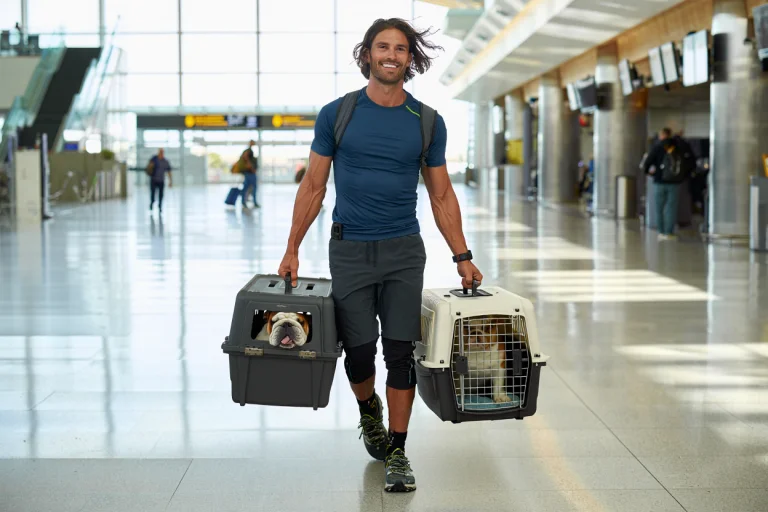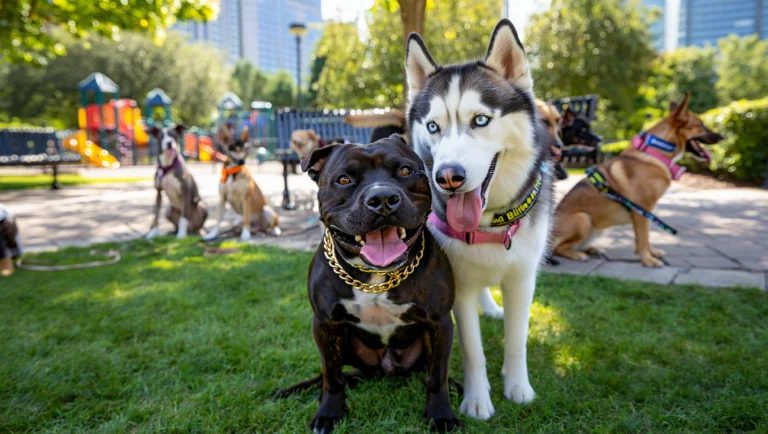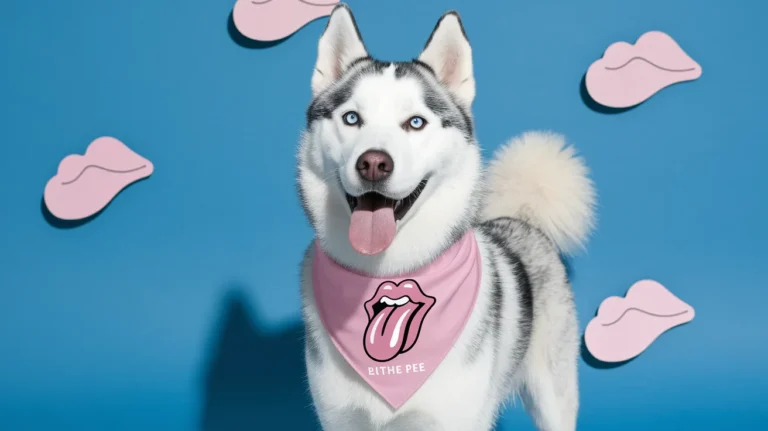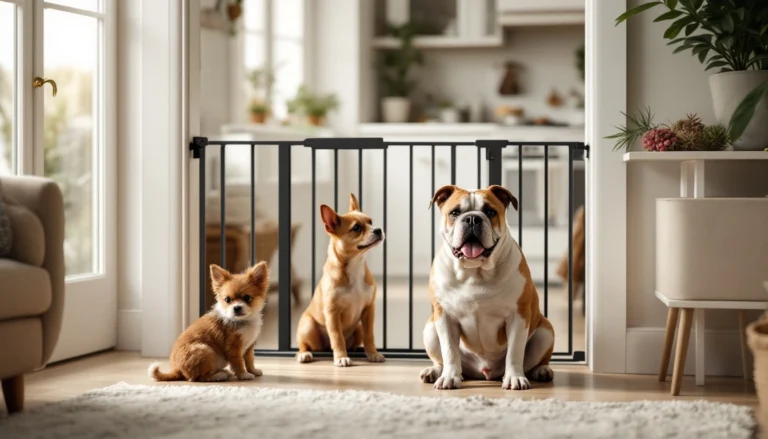Discover the best dog carriers for travel and comfort in our comprehensive guide covering all carrier types, features, and recommendations for safe pet transportation.
Table of Contents
Finding the perfect dog carrier for your four-legged friend can make all the difference when it comes to travel experiences, veterinary visits, or everyday outings. A high-quality dog carrier not only ensures your pet’s safety and comfort but also provides convenience for you as a pet parent. Whether you have a tiny Chihuahua or a medium-sized Beagle, the right carrier can transform potentially stressful situations into seamless adventures. In this comprehensive guide, we’ll explore everything you need to know about selecting the best dog carrier for your specific needs, from understanding different types to essential features and top recommendations.

Understanding Different Types of Dog Carriers
Soft-Sided Carriers
Soft-sided carriers are among the most popular options for dog owners, particularly those with small to medium-sized breeds. These carriers are typically made from durable fabrics like nylon or polyester with mesh windows for ventilation and visibility.
Advantages:
- Lightweight and easier to carry than hard-sided alternatives
- Often feature padded shoulder straps or handles for comfortable transport
- Many are collapsible for convenient storage when not in use
- Generally more affordable than hard carriers
- Provide a cozy, den-like environment that many dogs prefer
Disadvantages:
- Less structural protection than hard-sided carriers
- May not be suitable for dogs who chew or scratch
- Can be more challenging to clean thoroughly
Best for: Small to medium dogs who are relatively calm and don’t need extensive protection. Perfect for airline travel (under-seat), short trips, and vet visits.
Hard-Sided Carriers
Hard-sided dog carriers provide maximum protection and security with their durable plastic, fiberglass, or metal construction. These carriers typically feature a solid top, bottom, and sides with ventilation holes or wire doors.
Advantages:
- Superior protection and durability
- Easier to clean and disinfect
- Better structural integrity for stacking or securing during travel
- More escape-proof for determined dogs
- Provide better protection from external elements
Disadvantages:
- Heavier and bulkier than soft carriers
- Not collapsible or easily storable
- Sometimes less comfortable for the dog
- Can be more expensive depending on quality and size
Best for: Air travel in cargo holds, car travel, dogs who need more security, and pets who might chew through soft carriers.
Backpack Carriers
Backpack carriers have become increasingly popular for small dog owners who want hands-free transportation. These carriers are worn like a traditional backpack but feature special compartments designed to safely hold and transport your dog.
Advantages:
- Hands-free transportation
- Excellent for hiking, biking, or urban exploration
- Many feature multiple pockets for storing pet supplies
- Often include safety harness attachments inside
- Weight distribution makes carrying more comfortable for longer periods
Disadvantages:
- Limited to smaller dogs (typically under 20 pounds)
- Some dogs may feel anxious in the vertical position
- Less spacious than other carrier options
- Can become uncomfortable for the human carrier over extended periods
Best for: Active pet parents with small dogs who enjoy outdoor adventures or urban exploration.
Sling Carriers
Sling carriers are designed to carry small dogs close to your body in a pouch-like design. They typically loop over one shoulder and across your body with your dog nestled in the fabric pouch.
Advantages:
- Keeps your dog very close for bonding and security
- Lightweight and minimal design
- Easy to put on and take off
- Often machine washable
- Can help anxious dogs feel secure
Disadvantages:
- Only suitable for very small dogs (usually under 10-15 pounds)
- Limited security features
- Less protection from elements
- May cause shoulder strain with heavier dogs
Best for: Very small or toy breeds who enjoy being close to their owners, short trips, and dogs who get anxious in traditional carriers.
Wheeled Carriers
Wheeled dog carriers resemble rolling luggage with special compartments and features designed for pet transportation. These carriers typically have a handle for pulling and wheels for easy maneuverability.
Advantages:
- Reduces physical strain when transporting your dog
- Ideal for airport navigation and long distances
- Often convertible to backpacks or traditional carriers
- Many include multiple storage compartments
- Available in both hard and soft-sided versions
Disadvantages:
- Bulkier and heavier than non-wheeled alternatives
- May be challenging on uneven surfaces
- Higher price point than simple carriers
- Some dogs may find the rolling motion unsettling
Best for: Travelers with small to medium dogs, pet parents with mobility issues, and longer journeys where carrying your dog would be tiring.
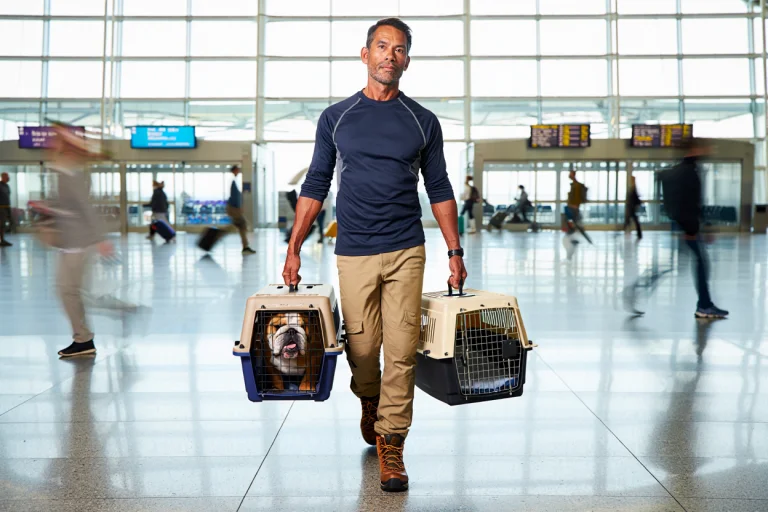
Key Features to Consider When Choosing a Dog Carrier
Size and Weight Capacity
The most crucial factor when selecting a dog carrier is ensuring proper sizing. Your dog should be able to stand up, turn around, and lie down comfortably inside the carrier. The general rule is to measure your dog from nose to tail and from floor to shoulder, then add 2-4 inches to each measurement to determine the minimum carrier size.
Most carriers specify weight limits, which typically range from:
- Small carriers: Up to 10 pounds
- Medium carriers: 10-20 pounds
- Large carriers: 20-40 pounds
Remember that a carrier that’s too small will be uncomfortable and potentially unsafe for your dog, while one that’s too large may not provide enough security and stability.
Ventilation and Visibility
Proper airflow is essential for your dog’s comfort and safety. Look for carriers with multiple mesh panels or ventilation holes that allow fresh air to circulate. These openings also provide visibility, allowing your dog to see outside, which can reduce anxiety for many pets.
The best carriers strike a balance between:
- Enough ventilation to prevent overheating
- Sufficient visibility for your dog to feel connected to the environment
- Some private, enclosed space for dogs who prefer security
Durability and Materials
The materials used in dog carriers significantly impact their durability, weight, and comfort. Common materials include:
- Nylon and polyester: Lightweight and water-resistant, ideal for soft carriers
- Reinforced plastic: Durable and easy to clean, common in hard-sided carriers
- Oxford fabric: Tear-resistant and sturdy, used in premium soft carriers
- Mesh panels: Provide ventilation and visibility while maintaining structure
- Memory foam: Offers comfort in premium carriers with padded bottoms
Look for reinforced stitching, quality zippers, and sturdy hardware, as these are typically the first components to fail with regular use.
Security Features
A secure carrier prevents escape attempts and protects your dog during transportation. Essential security features include:
- Locking mechanisms: Secure latches or zippers that prevent accidental opening
- Interior leash attachments: Clips to connect to your dog’s harness or collar
- Reinforced seams: Prevent determined dogs from creating escape routes
- Sturdy bottom panel: Maintains structural integrity when carried
For air travel, look for carriers specifically designed to meet airline requirements, which often include special locking mechanisms and reinforced construction.
Comfort and Padding
Your dog’s comfort during transport can make the difference between a stressful experience and a relaxed journey. Features that enhance comfort include:
- Padded bottom: Cushions your dog during transport
- Removable fleece or soft liners: Provides comfort and makes cleaning easier
- Adjustable space: Some carriers expand to give dogs more room when needed
- Padded walls: Protect against bumps during transport
For longer journeys, premium padding becomes even more important to prevent discomfort and stress.
Ease of Cleaning
Dogs can have accidents, get motion sickness, or simply bring dirt and hair into their carriers. Features that make cleaning easier include:
- Removable and machine-washable liners
- Waterproof or water-resistant materials
- Smooth interior surfaces in hard carriers that can be wiped clean
- Access panels that open fully for thorough cleaning
Carriers with sealed seams and fewer fabric folds tend to be easier to maintain and keep odor-free.
Portability and Storage
Consider how you’ll transport and store the carrier when not in use:
- Collapsible designs: Fold flat for storage
- Multiple carrying options: Handles, shoulder straps, or backpack straps
- Lightweight materials: Reduce carrying strain
- Compatibility with car seat belts: Allow secure fastening in vehicles
If you’ll be using public transportation or navigating busy airports, prioritize carriers with multiple carrying options and streamlined designs.
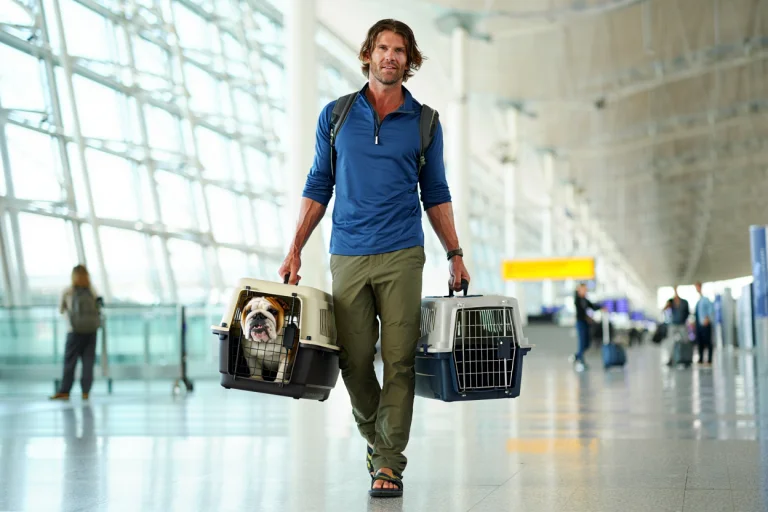
Top Dog Carriers by Travel Type
Best for Air Travel
When flying with your dog, airline-approved carriers are essential. For cabin travel, soft-sided carriers that fit under the seat are preferred, while cargo transport typically requires hard-sided carriers with specific features.
Cabin Travel Requirements:
- Must fit under the seat in front of you (typically 18″ L x 11″ W x 11″ H)
- Adequate ventilation on at least two sides
- Waterproof bottom
- Secure closure mechanisms
- Soft sides that can compress slightly
Cargo Requirements:
- Hard-sided construction
- Ventilation on all four sides
- Secure, metal door
- Food and water dishes that attach to the door
- “Live Animal” stickers and proper labeling
Always check with your specific airline, as requirements can vary significantly between carriers.
Best for Car Travel
Car travel presents different challenges than air travel, with safety during potential accidents being a primary concern.
Key features for car carriers include:
- Crash-tested designs (look for Center for Pet Safety certification)
- Ability to be secured with seat belts or LATCH systems
- Reinforced structure to withstand impact
- Easy access to place and remove your dog
- Proper ventilation for longer journeys
Some carriers can double as car seats with special viewing windows and safety harness attachments.
Best for Public Transportation
Navigating buses, trains, and subways requires carriers that are compact, lightweight, and easy to manage in crowded spaces.
Look for:
- Streamlined design that won’t bump into other passengers
- Multiple carrying options (handles and straps)
- Secure closures that won’t accidentally open
- Durable bottoms that can be set down on various surfaces
- Weather protection features if you’ll be waiting outdoors
Backpack and sling carriers often excel in these environments by keeping your hands free for tickets, phones, and other essentials.
Best for Outdoor Adventures
For hiking, camping, or outdoor exploration, specialized carriers provide features suited to natural environments.
Outdoor-friendly features include:
- Weather-resistant materials
- Enhanced ventilation for temperature regulation
- Durable construction that withstands rough terrain
- Storage compartments for water, treats, and waste bags
- Reflective strips for visibility in low light
- Stabilizing features for uneven ground
Backpack carriers and rugged soft-sided carriers typically perform best for outdoor adventures.
Special Considerations for Different Dog Types
For Anxious Dogs
Dogs with anxiety require carriers that provide a sense of security and comfort. Features that help anxious dogs include:
- Partially covered sides that create a den-like environment
- Soft, familiar bedding that can be placed inside
- Room for comfort items like toys or clothing with your scent
- Minimal external stimulation (fewer mesh windows)
- Top-loading options that make placement less stressful
Some carriers now include special features like pheromone diffuser pockets or sound-dampening materials specifically designed for anxious pets.
For Senior Dogs
Older dogs often have different needs when it comes to carriers, including:
- Extra padding to protect aging joints
- Easy entry with low threshold or wide openings
- Climate control features for dogs with temperature sensitivity
- Room for medications or special supplies
- Lighter weight materials to reduce owner strain
Memory foam padding and orthopedic supports can make a significant difference in comfort for senior dogs.
For Puppies
Puppies bring their own challenges to carrier selection:
- Chew-resistant materials and reinforced corners
- Waterproof and easily cleanable surfaces for accidents
- Secure closures that curious puppies can’t figure out
- Room to grow (consider adjustable carriers)
- Visibility for socialization during critical periods
Many puppy owners find that investing in an adjustable carrier with removable dividers allows the carrier to grow with their dog.
Health and Safety Considerations
Proper Carrier Sizing
Using an appropriately sized carrier is crucial for your dog’s health and safety. Signs that a carrier is too small include:
- Inability to stand up fully and turn around
- Hunched posture when standing
- Inability to lie down comfortably
- Excessive panting or signs of discomfort
- Restricted movement
Conversely, carriers that are too large may not provide enough security, potentially causing anxiety or allowing your dog to be thrown around during transport.
Temperature Management
Dogs can quickly overheat or become too cold in carriers with inadequate ventilation or insulation. Consider:
- Carriers with multiple ventilation panels for hot weather
- Insulated carriers or add-on thermal pads for cold conditions
- Never leaving your dog unattended in a carrier in extreme temperatures
- Carriers with shade features for sunny conditions
- Monitoring your dog for signs of heat stress or cold stress
Some premium carriers now include temperature monitors or improved airflow designs specifically engineered for climate control.
Stress Reduction
Transport can be stressful for many dogs, but the right carrier can help mitigate this:
- Familiarize your dog with the carrier before travel by making it a positive space
- Include familiar-smelling items like a blanket or toy
- Consider carriers with privacy panels that can be adjusted based on your dog’s preference
- Look for carriers with minimal rattling or noise during transport
- Choose carriers with stable bottoms that don’t shift or sway
Taking time to properly introduce your dog to their carrier can significantly reduce travel stress.
Recommended Dog Carriers on Amazon
For Small Dogs (Under 10 pounds)
- PetAmi Deluxe Pet Carrier Backpack
- Perfect for small dogs who enjoy seeing the world
- Features multiple mesh windows, padding, and safety strap
- Sherpa Original Deluxe Pet Carrier
- Airline-approved for cabin travel
- Includes plush bedding and reinforced construction
For Medium Dogs (10-20 pounds)
- K&H Pet Products Travel Safety Carrier
- Crash-tested for car safety
- Features easy setup and comfortable interior
- Pet Gear I-GO2 Escort Roller Backpack
- 5-in-1 carrier functions as backpack, roller, tote, carrier, and car seat
- Ideal for versatile transportation needs
Frequently Asked Questions About Dog Carriers
How do I measure my dog for the right carrier size?
Measure your dog while they’re standing from the tip of their nose to the base of their tail for length. Then measure from the floor to the top of their shoulder for height. Add 2-4 inches to each measurement to determine the minimum interior dimensions needed for your dog’s carrier. Weight is also important, but dimensions ensure proper fit regardless of your dog’s build.
Are airline requirements the same for all carriers?
No, airline requirements vary significantly between companies. Always check with your specific airline before traveling, as some have stricter size limitations or material requirements. Generally, in-cabin carriers must fit under the seat in front of you and provide adequate ventilation, while cargo carriers must meet IATA (International Air Transport Association) guidelines for construction and security.
How do I get my dog comfortable with using a carrier?
Introduce the carrier gradually in a positive way:
- Leave the carrier open in your home with comfortable bedding inside
- Place treats and favorite toys inside the carrier
- Feed meals near or inside the carrier
- Practice short closures while providing treats and praise
- Take brief trips around the house before attempting longer journeys
- Use calming pheromone sprays designed for carriers if needed
This process may take days or weeks depending on your dog’s temperament.
How often should I replace my dog’s carrier?
Most quality dog carriers should last 3-5 years with regular use, but this depends on:
- Frequency of use
- Your dog’s behavior (chewing, scratching)
- Exposure to elements
- Quality of construction
Signs it’s time to replace a carrier include damaged zippers, cracks in plastic components, structural weakness, or worn straps that compromise safety.
Can I use a cat carrier for my small dog?
While some carriers are marketed for both cats and small dogs, there are important differences to consider:
- Dog carriers often have more ventilation
- Cat carriers typically have smaller doors
- Dog-specific carriers may have additional security features
- Dogs generally benefit from more visibility than cats prefer
For occasional use, a cat carrier might work for a small dog, but for regular transportation, a dog-specific carrier is recommended.
Are expensive carriers worth the investment?
Higher-priced dog carriers often offer:
- More durable materials and construction
- Better safety features
- Enhanced comfort features like premium padding
- Longer warranties
- Better design for specific uses (airline approval, car safety, etc.)
For frequent travelers or pet parents with dogs who have specific needs, premium carriers can be a worthwhile investment that saves money over time.
How do I clean and maintain my dog carrier?
Cleaning methods vary by carrier type:
- Soft carriers: Remove washable liners and follow manufacturer instructions for cleaning the shell (often spot cleaning or gentle cycle washing)
- Hard carriers: Disassemble if possible and clean with pet-safe disinfectant
- Regular maintenance: Inspect seams, zippers, and latches monthly
- Odor control: Use enzymatic cleaners specifically designed for pet odors
- Storage: Store clean and completely dry to prevent mold or mildew
Always follow manufacturer cleaning instructions to avoid damaging waterproofing or structural components.
Preparing Your Dog for Carrier Travel
Successfully acclimating your dog to their carrier involves patience and positive association. Start with these steps:
- Initial introduction: Place the carrier in a common area with the door open
- Create positive associations: Put treats, toys, and comfortable bedding inside
- Feeding time: Begin feeding meals near the carrier, gradually moving the bowl inside
- Short containment: Once comfortable entering, close the door briefly while providing treats
- Movement practice: Begin lifting and moving the carrier for short periods
- Home practice: Carry your dog around the house in the carrier before venturing outside
- Short trips: Start with brief car rides to positive destinations (not just the vet)
This gradual approach helps most dogs develop comfort and even enjoyment of their carrier. For particularly anxious dogs, consult with a veterinary behaviorist for additional strategies.
Traveling Internationally with Your Dog Carrier
International travel presents additional considerations for dog carriers:
- Airline regulations: International flights often have stricter requirements
- Country-specific rules: Some nations have specific carrier standards for entry
- Extended comfort: Longer flights require carriers with enhanced padding and space
- Identification: Multiple ID tags and microchip information should be attached
- Documentation holders: Clear pouches for health certificates and travel documents
Research destination country requirements thoroughly and consider consulting with a pet travel specialist for international journeys.
Environmental Impact of Dog Carriers
With growing environmental consciousness, many pet parents seek sustainable carrier options:
- Eco-friendly materials: Recycled fabrics, sustainable bamboo, and organic cotton
- Durability: Well-made carriers that last longer create less waste
- Multi-purpose designs: Carriers that serve multiple functions reduce the need for multiple products
- End-of-life considerations: Some manufacturers offer recycling programs for used carriers
- Local production: Carriers made closer to home often have smaller carbon footprints
Several brands now specifically focus on creating environmentally responsible pet carriers with transparent supply chains and sustainable materials.
Conclusion
Finding the perfect dog carrier involves careful consideration of your dog’s size, temperament, and your specific travel needs. A well-chosen carrier not only ensures safe and comfortable transportation but can also reduce stress for both you and your pet during travel. By prioritizing proper sizing, security features, comfort, and appropriate carrier type for your activities, you’ll create positive travel experiences that you and your dog can enjoy together.
Remember that the best carrier is one that meets both your practical needs and your dog’s comfort requirements. Take time to properly introduce your dog to their new carrier, and you’ll be rewarded with a travel companion who views their carrier as a safe space rather than a source of anxiety.
We’d love to hear about your experiences with different dog carriers and any tips you’ve discovered along the way. For more expert recommendations on pet care essentials and travel tips, be sure to explore BlithePet for our comprehensive guides and product reviews.

